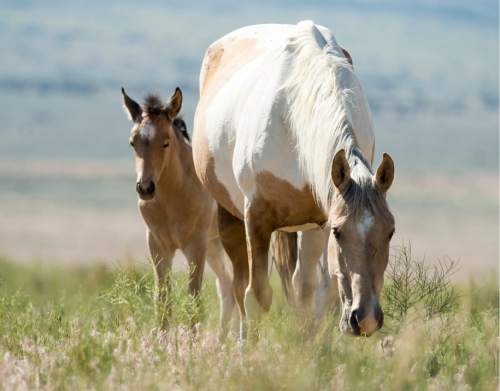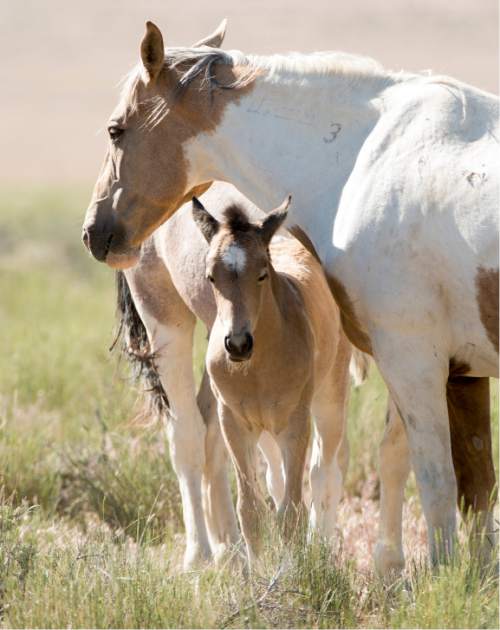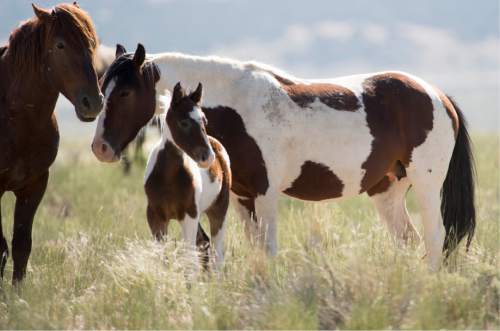This is an archived article that was published on sltrib.com in 2015, and information in the article may be outdated. It is provided only for personal research purposes and may not be reprinted.
Sometime this year, federal land managers plan to shoot a "fertility vaccine" into the haunches of wild horses in Tooele County's Onaqui herd.
Using dart guns instead of helicopters, wranglers and biologists hope to cut horse numbers among Utah's most photographed herd.
The Bureau of Land Management pitches the mass vaccinations, to be administered annually for the next five years, as a humane alternative to the controversial and costly roundups demanded by the state's ranchers and rural county commissioners angry about the proliferation of wild horses across public rangelands.
But wild-horse lovers are split by the BLM's new methodology for controlling wild horse populations in the West.
Years of roundups have failed to control populations of free-roaming equines, and now horses and burros in lifelong captivity outnumber the estimated 49,000 on the range.
A vocal and litigious faction of animal-welfare advocates is trying to block the BLM's use of the vaccine as part of a campaign to increase the role of contraception in horse management.
The drug in question is Porcine Zona Pellucida (PZP), which is based on a protein extracted from pig eggs and stimulates an immune response that thwarts fertilization when injected into the muscle tissue of large female mammals.
Critics allege PZP disrupts horses' social lives and called on the BLM to let nature control horse numbers by reintroducing "apex predators" on the range and removing cattle.
Anne Novak, founder of the Bay Area-based Protect Mustangs, denounced injecting young mares as "barbaric."
"Her reproductive system has not developed completely," she writes in her group's comments about the plan. "Forced drugging of fillies and mares until they [reach age 6] will ruin their chances of ever producing healthy offspring who can survive the environmental changes ahead."
But Deniz Bolbol, a spokeswoman for American Wild Horse Preservation Campaign, believes Novak represents the view of two tiny "fringe" groups and does not reflect a genuine controversy. AWHPC is part of a 60-group coalition that endorses contraception as an alternative to surgical sterilization and horse removal.
"There is a handful of people spreading misinformation and opposing the best-case scenario for humane management," says Bolbol, who is trained to administer PZP using dart guns. "You have fringe groups raising these allegations that are not based on science, and it's detracting from the strong unity of support for fertility control."
—
Fertility "vaccines" • The Onaqui plan is a rare instance in which horse advocates applaud the BLM. AWHPC members would like to see the agency inoculate 8,000 mares a year — about a tenfold increase in the number treated in recent years — and phase out roundups.
PZP, long used on large zoo animals and wildlife species, has proven a success in controlling horse numbers with BLM-managed herds in the Pryor Mountains of Montana and Little Book Cliffs of Colorado, according to Jay Kirkpatrick, the veterinarian who developed the vaccine in the 1970s. Kirkpatrick's Billings, Mont.-based nonprofit Science and Conservation Center manufacturers PZP and sells it at 60 percent of cost.
"It's not experimental. It's old hat," says Kirkpatrick, who rejects critics' claims that he is motivated by profit.
He says contraception is by far the best of three options for managing wild horses, descendants of domesticated horses that Spanish explorers and Anglo settlers turned loose beginning in the 1500s. With few wolves and mountain lions to prey on horses, herd sizes can double in four to six years.
"They can leave the horses alone," Kirkpatrick says, "and watch them destroy the range."
Or, he says, the BLM could keep rounding up horses. But that stimulates the reproductivity of the remaining horses, and the practice has accomplished nothing but increasing the burden on taxpayers.
And what about kicking ranchers off the land, as some horse advocates insist?
"That is not going to happen," Kirkpatrick says, "and if you did, it would only buy time before you had a giant wild horse problem."
Ranching groups and Utah officials have sued the BLM for failing to keep horse numbers within the "appropriate management levels" the agency has designated for the state's 19 herds of wild horses and burros.
—
A test case • A 2013 National Academy of Sciences study strongly endorsed immunocontraception as the best, perhaps only, pathway out of the BLM's horse predicament. Federal law protects wild horses, which cannot be hunted and are revered among animal lovers around the world.
It costs the BLM about $300 per horse to administer PZP — an amount that is far cheaper than the millions spent on helicopter roundups and long-term pasturing of removed horses.
The Onaqui darting plan is considered a test for increased reliance on PZP, but it would be hard to replicate around the state because few horses can be approached as easily as the often-photographed animals near Dugway.
In the coming months, specially trained BLM staff and volunteers, armed with pressurized air guns, will shoot self-injecting darts into dozens of mares that occupy the Onaqui horse-management area — a 206,795-acre span that encompasses the Onaqui and Simpson mountains separating the Skull and Rush valleys about 40 miles west of Provo in Tooele County's West Desert.
A veteran of darting programs in Nevada, Bolbol says she tries to get within 15 to 30 yards of a mare and aims her air rifle for the middle of the hip.
"It's time-consuming," she says. "You don't take a shot if there is a horse behind her or if the wind is blowing. The horses will look at you, like, 'What was that poof?' The darted horse will do a little giddy-up and run for 30 or 40 yards and start grazing again."
The dart self-injects the PZP and quickly falls out. The shooter must retrieve it to confirm the injection occurred.
"You have to wait for the mares to leave so they don't equate you with the dart," Bolbol says. "Contraception is about data collection — who you're darting, which band they belong to — and going back to see who foals the next year."
But critics find fault all through the plan, even in the four-inch brands seared into the rumps of inoculated mares.
The BLM "plans to disfigure the Onaqui fillies and mares with huge freeze-marks on the hip for staff's administrative convenience," wrote Florida resident Marybeth Devlin in an appeal. "It is unacceptable to uglify America's wild horses."
From Bolbol's perspective, a brand is harmless compared with surgically removing horses ovaries or testicles, which the BLM is considering in some cases. Putting geldings back on the range would be cruel and accomplish nothing, she says, since a single stallion would happily take up the slack.
The Onaqui's target population is 121 to 210 adults, and the current number is 317 — up nearly 140 animals since the BLM last treated the herd in 2012.
In that roundup, the agency spent $82,000 gathering 155 horses. Wranglers administered PZP to 57 mares and released them along with 64 stallions. Thirty-four horses were removed, including one that died.
The new program's goal is to slow Onaqui's annual growth rate to 7 percent and eventually get the adult population to between 160 and 175.
"The long-term goal is to reduce the need for gathers and removals, without jeopardizing the genetic health of the herd," states an Environmental Assessment.
According to the assessment, the program was to start in late May.
But that has been postponed while Devlin's appeal remains under review. It alleges the BLM failed to show the Onaqui herd is overpopulated and that PZP is safe.
—
Ending the debate • Once the program commences, the BLM will administer primer inoculations to mares over age 18 months each winter and a standard dose annually to older horses until 2020. Treated mares older than 5 will be spared further inoculations until they foal.
The idea is to give every mare a shot at contributing to the herd's genetic pool, according to Bolbol. The BLM anticipates many mares will not be easily darted.
"If it is determined that a mare or mares cannot be approached within darting range on foot, then baiting (not trapping) would be used to treat the mares," the assessment states. "Baiting would be with salt, mineral, or weed-free hay in areas that horses utilize in their normal movements."
Bolbol emphasizes that the vaccine does not prevent ovulation, nor does it manipulate hormone levels. Years of research have yet to demonstrate PZP affects mares' behavior or social standing — other than what comes with not getting pregnant.
While critics allege PZP causes mares to switch band allegiances, their opposition is grounded mostly in philosophy.
"We don't believe humans should be managing any wild animal, whether it be keeping them in small 'herd areas,' or limiting their population (whether through culling, relocation, or use of contraceptives, like PZP)," says Michael Harris, wildlife law director for Friends of Animals.
That position ignores the physical and political realities on the range, not to mention decades of wildlife management by state agencies, contraception proponents say.
"Leaving the animals alone is the ideal," Bolbol says. "But in today's world, there are fences and urban sprawl."







